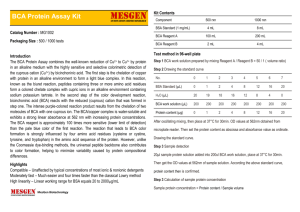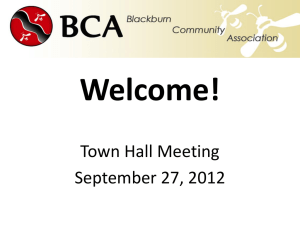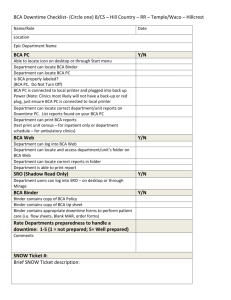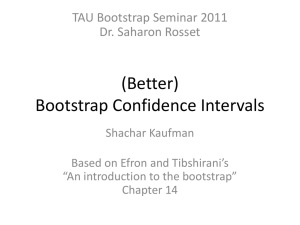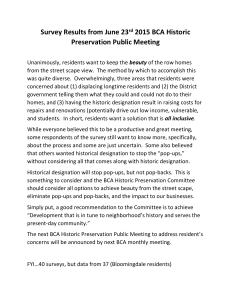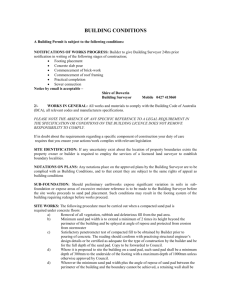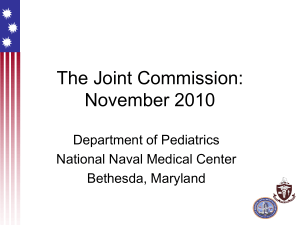Practice Note 2014-06-Fire Risk Assessments and Alternative
advertisement
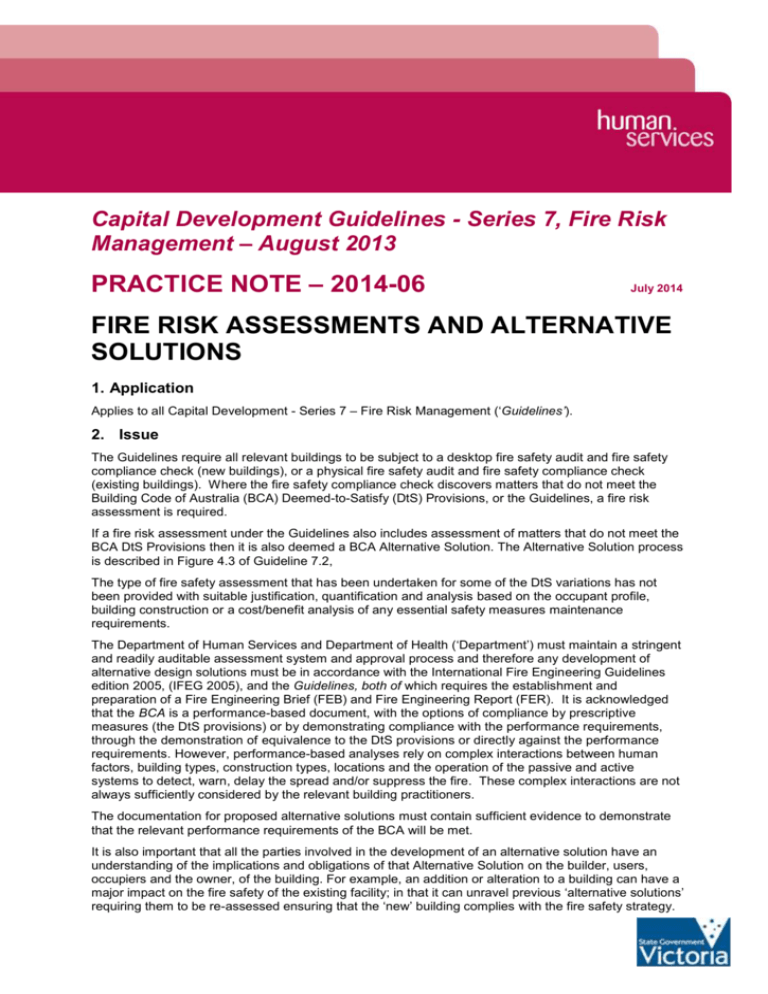
Capital Development Guidelines - Series 7, Fire Risk Management – August 2013 PRACTICE NOTE – 2014-06 July 2014 FIRE RISK ASSESSMENTS AND ALTERNATIVE SOLUTIONS 1. Application Applies to all Capital Development - Series 7 – Fire Risk Management (‘Guidelines’). 2. Issue The Guidelines require all relevant buildings to be subject to a desktop fire safety audit and fire safety compliance check (new buildings), or a physical fire safety audit and fire safety compliance check (existing buildings). Where the fire safety compliance check discovers matters that do not meet the Building Code of Australia (BCA) Deemed-to-Satisfy (DtS) Provisions, or the Guidelines, a fire risk assessment is required. If a fire risk assessment under the Guidelines also includes assessment of matters that do not meet the BCA DtS Provisions then it is also deemed a BCA Alternative Solution. The Alternative Solution process is described in Figure 4.3 of Guideline 7.2, The type of fire safety assessment that has been undertaken for some of the DtS variations has not been provided with suitable justification, quantification and analysis based on the occupant profile, building construction or a cost/benefit analysis of any essential safety measures maintenance requirements. The Department of Human Services and Department of Health (‘Department’) must maintain a stringent and readily auditable assessment system and approval process and therefore any development of alternative design solutions must be in accordance with the International Fire Engineering Guidelines edition 2005, (IFEG 2005), and the Guidelines, both of which requires the establishment and preparation of a Fire Engineering Brief (FEB) and Fire Engineering Report (FER). It is acknowledged that the BCA is a performance-based document, with the options of compliance by prescriptive measures (the DtS provisions) or by demonstrating compliance with the performance requirements, through the demonstration of equivalence to the DtS provisions or directly against the performance requirements. However, performance-based analyses rely on complex interactions between human factors, building types, construction types, locations and the operation of the passive and active systems to detect, warn, delay the spread and/or suppress the fire. These complex interactions are not always sufficiently considered by the relevant building practitioners. The documentation for proposed alternative solutions must contain sufficient evidence to demonstrate that the relevant performance requirements of the BCA will be met. It is also important that all the parties involved in the development of an alternative solution have an understanding of the implications and obligations of that Alternative Solution on the builder, users, occupiers and the owner, of the building. For example, an addition or alteration to a building can have a major impact on the fire safety of the existing facility; in that it can unravel previous ‘alternative solutions’ requiring them to be re-assessed ensuring that the ‘new’ building complies with the fire safety strategy. In some cases the alteration or addition, without being properly addressed and assessed through a fire risk assessment, can cause the existing building to become non-compliant, or even unsafe. 3. Background The purpose the Guidelines is to provide appropriate levels of fire safety for staff, clients and other occupants of a building, in part by providing for appropriately qualified professionals such as Fire Safety Engineers, Building Surveyors and Building Inspectors, to audit, assess and recommend steps to minimise fire risk, and to assess and report on acceptable standards of fire safety, in specific settings. The BCA is a performance based document which allows the application of fire safety engineering principles to ascertain compliance with the performance requirements specified to meet the requirements of the current Building Regulations. This enables a flexible approach to be applied to develop a building solution to achieve a satisfactory level of fire safety. The particular requirements for fire safety will depend on the circumstances, including the various matters identified and considered in the Guidelines (e.g. building use, occupant and staff profiles, primary and supplementary fire safety objectives, etc.). The BCA DtS provisions are general in their nature and do not necessarily take into account the specific circumstances of every case. Compliance only with the BCA DtS may not be sufficient to provide compliance with the health and safety duties of the Department or take into consideration the real needs of a vulnerable person. The Guidelines mandatory measures and ’Other Department Specific Measures’ take into account the specific nature and use of a building subject to the Guidelines. Consideration should be given at all times to whether additional measures need to be taken for fire safety in the particular circumstances. 4. Analysis All the stakeholders must be represented, and in particular the Department, on any FEB and FER for which the Department or Director of Housing has an interest and any proposed alternative design solution must be agreed to by the Fire Risk Management Unit (FRMU) of the Department. It has been found in some cases that only the architect, building surveyor and fire safety engineer are represented on the FEB, which is in direct conflict with the requirements of the Guidelines and the IFEG 2005. The purpose of the FEB is to outline the process that defines the scope of work for the fire safety engineering analysis and also the basis for analysis, and acceptance criteria, as agreed by all the stakeholders. Therefore it is important that all stakeholders are involved in the FEB process. A request for any proposed alternative design solution must be made to the FRMU and clearly identify:(a) the area of non-compliance (with specific reference to the appropriate section of the BCA DtS Provisions and/or Guideline); (b) the reason for the non-compliance; and (c) any potential risk to the public and/or occupant using the building; The fire safety engineer or relevant building surveyor must review the design documentation for the proposed building and also take into consideration the existing structure and fire safety systems (if an alteration or addition is proposed) to ensure that the conceptual design and existing building have been accurately translated into the design documentation. The document review should include identifying consistency or differences between the design documentation and the ‘as built’, to ensure that the fire risk assessment is, and always remains, valid. The fire safety engineer must take into account the whole building in any analysis. The fire safety engineer who is responsible for the preparation and certification of the alternative solution must be involved in the construction, commissioning and final approval stages of the building project to verify that the construction of the building is in accordance with all requirements of the fire engineering report and that any conditions applied to the building approval that relate to the fire engineering design has been satisfied. The Statement of Compliance – Design must be signed by the accredited Fire Safety Engineer who is responsible for the design. The review should take into account any modifications or additions, whether permanent or temporary, to determine any requirements or changes flowing from the alterations or additions to the building. What must be taken into account by the relevant building surveyor is Ministerial Guideline MG04, issued June 2005, pursuant to section 188(1)(c) of the Building Act 1993 (the Act) as follows:-. ‘In deciding whether to rely on a certificate of compliance in relation to a design by a registered building practitioner in the category of engineer, the relevant building surveyor must have regard to the complexity of the design and may determine that any such certificate be by a registered building practitioner in the category of engineer, other than the one who prepared the design’ 4.1. Use of Expert Judgement The BCA defines expert judgement as meaning ‘the judgement of an expert who has the qualification and experience to determine whether a Building solution complies with the performance requirements’ of the BCA. The issue is what the minimum qualification is and experience a person must have to be determined an expert. In determining whether an expert judgement can be used, professional standards must be taken into consideration similar to that required for building surveyors, refer to Ministerial Guideline MG05, issued June 2005 , pursuant to section 188(1)(c) of the Building Act 1993 (the Act), as follows:Municipal building surveyors and private building surveyors must only accept appointment as relevant building surveyors in the area of their own competence. Municipal building surveyors and private building surveyors must perform their functions in a competent manner and to a professional standard. Where there are variations from the DtS provisions of the BCA and there is a recognised calculation methodology for assessing a fire engineering solution, then expert judgment as a methodology for the assessment is not appropriate or acceptable. This is consistent with the requirements of IFEG 2005 and the Guidelines. It has been determined by the Department (CDG 7.2) that the use of expert judgement must not be used when there is a recognised calculation methodology available, it can be used as a supplementary component that improves the outcome, but not where it replaces a recognised calculation methodology. Inclusion of the Department and relevant fire brigade in the FEB/FER process will ensure this is satisfied. 5. Outcome (a) The Department and relevant fire brigade must be included in the FEB/FER process, unless either agrees in writing that involvement is not necessary in the specific circumstances. (b) The use of expert judgement must not be used when there is a recognised calculation methodology available. (c) The fire risk assessment must be in compliance with IFEG 2005 and the Guidelines 2013. Prior to undertaking the fire risk assessment, a Fire Engineering Brief (FEB) and Fire Engineering Report (FER) must be completed, addressed and accepted by all the stakeholders (refer to CDG 7.2). (d) All risk assessments related to the building are to take into consideration the whole building and any previous alternative solutions must be taken into account to determine if they are still valid or applicable to the building as a whole. The fire risk strategy for the complete building must be current and valid. (e) Any fire risk assessment (include alternative solutions, dispensations or modification to the BCA) must be undertaken or approved by an accredited Fire Safety Engineer (who will take full responsibility for the assessment). (f) A Statement of Compliance - Design (CDG 7.2 Form A1.2, Appendix 1) must be provided by the accredited Fire Safety Engineer responsible for the fire risk assessment. (g) The fire safety engineer must inspect the building to confirm that the building complies with all the requirements of the fire risk assessment and is to provide a compliance statement – Works (CDG 7.2 Form A1.2, Appendix 1). (h) A Statement of Compliance – Alternative Solutions (CDG 7.2 Form A1.1, Appendix 1) must be provided by the accredited building surveyor when they are satisfied that all matters contained with the fire risk assessment(s) have justified the performance requirements of the BCA and Guidelines, however it must be provided prior to the issue of the building permit or permits. The accredited building surveyor is still required to comply with the requirements of Regulation 113 of the Building Regulations. (i) The fire safety handbook must either be updated referencing all requirements or a new fire safety handbook must be developed and implemented refer to CDG 7.2. The fire safety handbook must be in accordance with the template published by the Department at the time. Endorsed by: Hank Van Ravenstein Principal Manager Fire Risk Management Unit Approved by: Terry Bevans Assistant Director Asset Maintenance, Property and Asset Services

